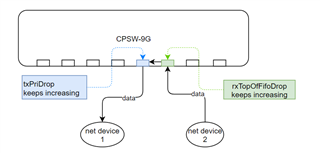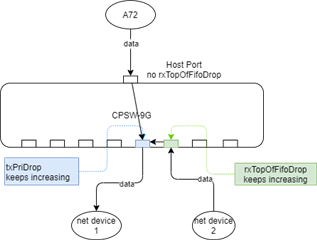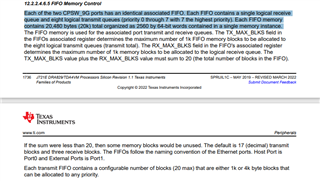Other Parts Discussed in Thread: TDA4VM
Hello, We encountered a packet loss problem when using CPSW-9G as a switch, here is the network topology of our project:

net device 2 sends data to net device 1 via CPSW-9G, and we found occasional packet loss in this chain. here is the log output of CPSW-9G printed by function "EnetAppUtils_printMacPortStats9G" after running for some time:
2024-03-13 23:39:20 [MCU2_0] 54465.384674 s: -------------- host port ---------------- 2024-03-13 23:39:20 [MCU2_0] 54465.384791 s: rxGoodFrames = 26205323 2024-03-13 23:39:20 [MCU2_0] 54465.384843 s: rxMcastFrames = 2749203 2024-03-13 23:39:20 [MCU2_0] 54465.384881 s: aleDrop = 1755431 2024-03-13 23:39:20 [MCU2_0] 54465.384918 s: rxOctets = 33460433846 2024-03-13 23:39:20 [MCU2_0] 54465.384954 s: txGoodFrames = 13340626 2024-03-13 23:39:20 [MCU2_0] 54465.384987 s: txBcastFrames = 2669 2024-03-13 23:39:20 [MCU2_0] 54465.385019 s: txMcastFrames = 1238382 2024-03-13 23:39:20 [MCU2_0] 54465.385055 s: txOctets = 1331271158 2024-03-13 23:39:20 [MCU2_0] 54465.385088 s: octetsFrames64 = 26396 2024-03-13 23:39:20 [MCU2_0] 54465.385121 s: octetsFrames65to127 = 15177207 2024-03-13 23:39:20 [MCU2_0] 54465.385155 s: octetsFrames128to255 = 1728356 2024-03-13 23:39:20 [MCU2_0] 54465.385188 s: octetsFrames256to511 = 547119 2024-03-13 23:39:20 [MCU2_0] 54465.385222 s: octetsFrames512to1023 = 1050898 2024-03-13 23:39:20 [MCU2_0] 54465.385255 s: octetsFrames1024 = 21015973 2024-03-13 23:39:20 [MCU2_0] 54465.385290 s: netOctets = 34791705004 2024-03-13 23:39:20 [MCU2_0] 54465.385325 s: portMaskDrop = 1755431 2024-03-13 23:39:20 [MCU2_0] 54465.385358 s: aleVidIngressDrop = 33 2024-03-13 23:39:20 [MCU2_0] 54465.385399 s: txPri[0] = 13313403 2024-03-13 23:39:20 [MCU2_0] 54465.385435 s: txPri[6] = 27222 2024-03-13 23:39:20 [MCU2_0] 54465.385471 s: txPriBcnt[0] = 1328411968 2024-03-13 23:39:20 [MCU2_0] 54465.385507 s: txPriBcnt[6] = 2857995 2024-03-13 23:39:20 [MCU2_0] 54465.385534 s: ----------- mac port 2 ----------- 2024-03-13 23:39:20 [MCU2_0] 54465.385569 s: rxGoodFrames = 11577923 2024-03-13 23:39:20 [MCU2_0] 54465.385604 s: rxBcastFrames = 2498 2024-03-13 23:39:20 [MCU2_0] 54465.385638 s: rxMcastFrames = 1132294 2024-03-13 23:39:20 [MCU2_0] 54465.385675 s: aleDrop = 82 2024-03-13 23:39:20 [MCU2_0] 54465.385709 s: rxOctets = 905449005 2024-03-13 23:39:20 [MCU2_0] 54465.385744 s: txGoodFrames = 32753380 2024-03-13 23:39:20 [MCU2_0] 54465.385799 s: txBcastFrames = 145 2024-03-13 23:39:20 [MCU2_0] 54465.385835 s: txMcastFrames = 7819695 2024-03-13 23:39:20 [MCU2_0] 54465.385875 s: txOctets = 38531878477 2024-03-13 23:39:20 [MCU2_0] 54465.385909 s: octetsFrames64 = 43956 2024-03-13 23:39:20 [MCU2_0] 54465.385942 s: octetsFrames65to127 = 15095509 2024-03-13 23:39:20 [MCU2_0] 54465.385976 s: octetsFrames128to255 = 2299516 2024-03-13 23:39:20 [MCU2_0] 54465.386010 s: octetsFrames256to511 = 409184 2024-03-13 23:39:20 [MCU2_0] 54465.386044 s: octetsFrames512to1023 = 3101162 2024-03-13 23:39:20 [MCU2_0] 54465.386078 s: octetsFrames1024 = 23381976 2024-03-13 23:39:20 [MCU2_0] 54465.386114 s: netOctets = 39437327482 2024-03-13 23:39:20 [MCU2_0] 54465.386148 s: portMaskDrop = 82 2024-03-13 23:39:20 [MCU2_0] 54465.386180 s: aleVidIngressDrop = 34 2024-03-13 23:39:20 [MCU2_0] 54465.386212 s: aleUnknownUcast = 18 2024-03-13 23:39:20 [MCU2_0] 54465.386244 s: aleUnknownUcastBcnt = 1268 2024-03-13 23:39:20 [MCU2_0] 54465.386277 s: aleUnknownMcast = 152 2024-03-13 23:39:20 [MCU2_0] 54465.386310 s: aleUnknownMcastBcnt = 12492 2024-03-13 23:39:20 [MCU2_0] 54465.386345 s: aleUnknownBcast = 96 2024-03-13 23:39:20 [MCU2_0] 54465.386377 s: aleUnknownBcastBcnt = 6160 2024-03-13 23:39:20 [MCU2_0] 54465.386412 s: alePolicyMatch = 11520066 2024-03-13 23:39:20 [MCU2_0] 54465.386454 s: txPri[0] = 32752300 2024-03-13 23:39:20 [MCU2_0] 54465.386493 s: txPri[6] = 1077 2024-03-13 23:39:20 [MCU2_0] 54465.386530 s: txPriBcnt[0] = 38531794932 2024-03-13 23:39:20 [MCU2_0] 54465.386566 s: txPriBcnt[6] = 80203 2024-03-13 23:39:20 [MCU2_0] 54465.386599 s: txPriDrop[0] = 386773 2024-03-13 23:39:20 [MCU2_0] 54465.386633 s: txPriDrop[6] = 48 2024-03-13 23:39:20 [MCU2_0] 54465.386668 s: txPriDropBcnt[0] = 223083172 2024-03-13 23:39:20 [MCU2_0] 54465.386704 s: txPriDropBcnt[6] = 3482 2024-03-13 23:39:20 [MCU2_0] 54465.386724 s: ----------- mac port 5 ----------- 2024-03-13 23:39:20 [MCU2_0] 54465.386779 s: rxGoodFrames = 11484631 2024-03-13 23:39:20 [MCU2_0] 54465.386819 s: rxBcastFrames = 171 2024-03-13 23:39:20 [MCU2_0] 54465.386853 s: rxMcastFrames = 8070930 2024-03-13 23:39:20 [MCU2_0] 54465.386890 s: rxOctets = 5959081594 2024-03-13 23:39:20 [MCU2_0] 54465.386925 s: txGoodFrames = 1964207 2024-03-13 23:39:20 [MCU2_0] 54465.386957 s: txBcastFrames = 2493 2024-03-13 23:39:20 [MCU2_0] 54465.386990 s: txMcastFrames = 1747697 2024-03-13 23:39:20 [MCU2_0] 54465.387025 s: txOctets = 192297929 2024-03-13 23:39:20 [MCU2_0] 54465.387059 s: octetsFrames64 = 26251 2024-03-13 23:39:20 [MCU2_0] 54465.387092 s: octetsFrames65to127 = 6007071 2024-03-13 23:39:20 [MCU2_0] 54465.387127 s: octetsFrames128to255 = 1860744 2024-03-13 23:39:20 [MCU2_0] 54465.387160 s: octetsFrames256to511 = 953251 2024-03-13 23:39:20 [MCU2_0] 54465.387194 s: octetsFrames512to1023 = 2134951 2024-03-13 23:39:20 [MCU2_0] 54465.387227 s: octetsFrames1024 = 2466570 2024-03-13 23:39:20 [MCU2_0] 54465.387262 s: netOctets = 6151379523 2024-03-13 23:39:20 [MCU2_0] 54465.387297 s: rxTopOfFifoDrop = 386821 2024-03-13 23:39:20 [MCU2_0] 54465.387330 s: aleUnknownUcast = 60 2024-03-13 23:39:20 [MCU2_0] 54465.387361 s: aleUnknownUcastBcnt = 5036 2024-03-13 23:39:20 [MCU2_0] 54465.387393 s: aleUnknownBcast = 19 2024-03-13 23:39:20 [MCU2_0] 54465.387427 s: aleUnknownBcastBcnt = 1216 2024-03-13 23:39:20 [MCU2_0] 54465.387461 s: alePolicyMatch = 9842036 2024-03-13 23:39:20 [MCU2_0] 54465.387499 s: ietRxSmdError = 1 2024-03-13 23:39:20 [MCU2_0] 54465.387535 s: txPri[0] = 1964206 2024-03-13 23:39:20 [MCU2_0] 54465.387570 s: txPriBcnt[0] = 192297871
As shown in the log, there are 386821 packets dropped by mac port 5 described as rxTopOfFifoDrop, and this drop is possibly caused by txPriDrop[0] + txPriDrop[6] of mac port 2.
I found this two items in the manual, described as:


but I can still not understand what this two items actually mean.
So could you please explain them to me in a more comprehensible way? and in what situation could this drop may happen?
Thank you very much!




